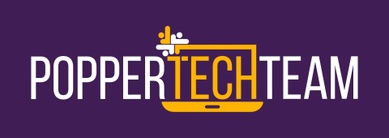
Cybersecurity threats are growing at an alarming rate, and Popper Tech Team is at the forefront of the battle. We spend countless hours not only defending against these threats but also educating clients and prospective customers about the risks they face. Yet, time and again, we hear the same misconceptions:
- “I don’t have anything of value.”
- “I’m too small to be a target.”
- “They don’t go after companies in my industry.”
- “It won’t happen to me.”
Let’s be clear: these assumptions are dangerously inaccurate.
The Scale of the Threat
To truly understand your risk, it’s essential to grasp the scope of the problem. The global malware industry is projected to reach a staggering $10.5 trillion by 2025. To put that into perspective, that’s about 10 cents out of every dollar in the world economy, which itself is estimated to reach $110 trillion by then. Imagine losing an economy the size of Germany and Japan combined—every year—to cybercrime.
Cybercriminals aren’t amateurs tinkering in basements. They operate like well-funded corporations with specialists, hierarchies, and global reach. Their full-time job? Stealing your money, your data, and your peace of mind.
How You Become a Target
Think you’re too small to be noticed? Think again. If you’re online, you have an IP address—your digital “phone number.” Hackers use automated tools that systematically scan and attack every IP address they can find, regardless of who you are or what you do. They aren’t picking targets; they’re fishing—and anyone in the water is at risk.
And fishing quickly turns into phishing. Hackers buy and sell email addresses on black markets, using them to send fraudulent emails. These emails might pose as your CEO asking for money, or they might lure you into revealing passwords. Once they’re in, they can escalate their attacks—potentially draining your bank account or worse.
A Real-Life Example
Let’s break down how a simple phishing scam can cost your business big:
- A hacker successfully targets your Accounts Receivable (AR) clerk via a phishing email.
- They log into the clerk’s email account and look for outgoing invoices.
- Let’s call your company MyCompany.com and your AR clerk JulieAR@mycompany.com.
- Let’s call your client Bigcompany.com and their AP clerk, JaneAP@bigcompany.com.
- The hacker creates an email rule in JulieAR’s email account to divert any replies from JaneAP into the trash folder, so JulieAR never sees them.
- The hacker—posing as JulieAR—emails your customer’s Accounts Payable (AP) department (JaneAP@bigcompany.com) with a request like this:
Hi Jane AP,
I wanted to follow up on your invoice #123456 for $120,000. Do you have everything you need? When will you be processing payment?
7. Your customer’s AP department replies, “We’ll process this next Friday.” Which JulieAR never sees because it was diverted to the trash. Then, the hacker posing as JulieAR sends a follow-up:
Thanks, Jane AP,
One more thing, we’ve updated our banking details. Please send payment to:
Routing: 111222333
Account: 444555666
If you don’t have proper controls in place, your customer just wired $120,000 to a criminal. And JulieAR? She’ll only realize the issue when she calls JaneAP to find out why your company hasn’t received the payment for $120,000. Worse, is the loss yours or your client? Do you want to have that argument with your client? In this real world example, mycompany.com chose to eat the loss rather than anger the client. Apply this example to your company. What is the largest invoice you send out monthly on average? Can your company sustain a loss of that size? What happens if they target more than one of your clients? At what point does this damage your business reputation or impact your ability to do business?
How You Can Fight Back
The good news? This entire attack can be stopped in its tracks with the right safeguards. Multi-Factor Authentication (MFA) is one of the simplest, most effective tools to prevent unauthorized access. By requiring a second form of verification (like a text message or app prompt), you make it exponentially harder for hackers to break in.
At Popper Tech Team, we help businesses like yours implement robust cybersecurity measures, including MFA, phishing protection, and more. Our goal is to keep your business safe so you can focus on what you do best.
Related
Why Your Business Needs Cyber Insurance Now More Than Ever
Joe Popper
The OG of IT
